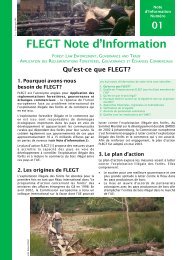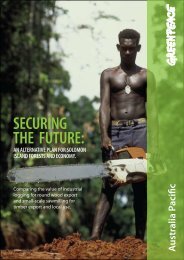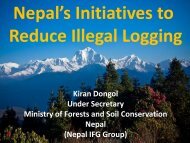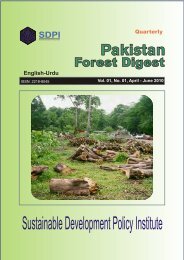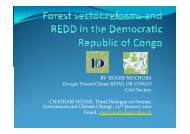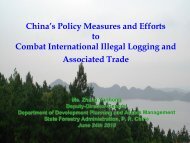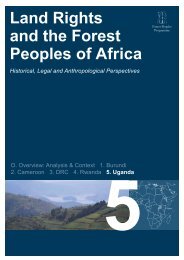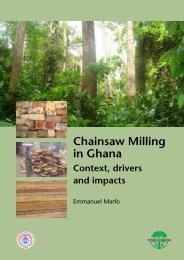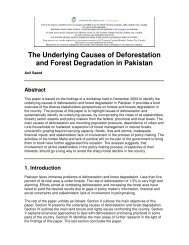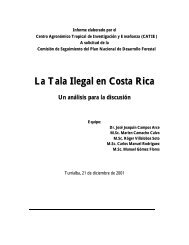conflict over natural resources at the community level in nepal
conflict over natural resources at the community level in nepal
conflict over natural resources at the community level in nepal
You also want an ePaper? Increase the reach of your titles
YUMPU automatically turns print PDFs into web optimized ePapers that Google loves.
5.0 PROGRAMMINGOPTIONS FORUSAID/NEPAL RELATEDTO MANAGING NATURALRESOURCE CONFLICTThe USAID Conflict Mitig<strong>at</strong>ion and Management Policy Implement<strong>at</strong>ion Guidel<strong>in</strong>es divides approaches to <strong>conflict</strong> <strong>in</strong>tomitig<strong>at</strong>ion and <strong>conflict</strong> management. Mitig<strong>at</strong>ion activities rel<strong>at</strong>ed to <strong>n<strong>at</strong>ural</strong> resource <strong>conflict</strong> could <strong>in</strong>clude<strong>community</strong>-based reconcili<strong>at</strong>ion us<strong>in</strong>g forest or w<strong>at</strong>er users’ groups as a po<strong>in</strong>t of entry for reconcil<strong>in</strong>g socialtensions. Conflict mitig<strong>at</strong>ion is dist<strong>in</strong>ct from o<strong>the</strong>r development assistance and has primarily short- andmedium-term goals. The programm<strong>in</strong>g options th<strong>at</strong> we propose below fall under <strong>the</strong> c<strong>at</strong>egory of Conflict-Sensitive Development and could provide a basis for a return to peace and democracy <strong>at</strong> <strong>the</strong> grassroots,district, and n<strong>at</strong>ional <strong>level</strong>s.5.1 IMPROVED GOVERNANCE AT THE USER GROUP LEVELUSAID/Nepal, though its SAGUN and SAMARPAN Programs, is work<strong>in</strong>g to improve <strong>n<strong>at</strong>ural</strong> resourceg<strong>over</strong>nance with<strong>in</strong> selected IWUAs, CFUGs, and BZUGs, specifically to encourage more equal particip<strong>at</strong>ionof disadvantaged groups and women with<strong>in</strong> <strong>the</strong> management structure of <strong>the</strong>se groups and to developmechanisms for more equitable shar<strong>in</strong>g of <strong>resources</strong> and benefits among user group members. It is not with<strong>in</strong><strong>the</strong> scope of this assessment to evalu<strong>at</strong>e <strong>the</strong> performance of <strong>in</strong>dividual projects, 4 however <strong>the</strong> f<strong>in</strong>d<strong>in</strong>gs of thisassessment <strong>in</strong>dic<strong>at</strong>e th<strong>at</strong> <strong>in</strong>terventions <strong>at</strong> <strong>the</strong> user group <strong>level</strong> are an effective means to address current <strong>n<strong>at</strong>ural</strong>resource <strong>conflict</strong> as well as lay <strong>the</strong> basis for a long-term system for manag<strong>in</strong>g <strong>conflict</strong> by ensur<strong>in</strong>g gre<strong>at</strong>erequality of resource access. Equality of access will help to relieve long-term social tensions, <strong>the</strong>reby remov<strong>in</strong>ga key grievance th<strong>at</strong> <strong>the</strong> Maoists used to build support for <strong>the</strong>ir cause. 5 Successfully <strong>in</strong>stitutionaliz<strong>in</strong>gdemocr<strong>at</strong>ic values and behavior <strong>at</strong> <strong>the</strong> user group <strong>level</strong> lays <strong>the</strong> found<strong>at</strong>ion for responsible particip<strong>at</strong>ion <strong>in</strong>democr<strong>at</strong>ic g<strong>over</strong>nance <strong>at</strong> <strong>the</strong> local and n<strong>at</strong>ional <strong>level</strong>s.Provid<strong>in</strong>g immedi<strong>at</strong>e benefits to poor and marg<strong>in</strong>alized people will help to allevi<strong>at</strong>e <strong>the</strong> severe livelihoodimpacts <strong>the</strong>y have suffered from <strong>the</strong> <strong>in</strong>surgency and will prepare <strong>the</strong>m to take a more active role <strong>in</strong> <strong>n<strong>at</strong>ural</strong>resource g<strong>over</strong>nance <strong>in</strong>stitutions <strong>in</strong> <strong>the</strong> post-<strong>conflict</strong> period. USAID support of user groups has <strong>the</strong> addedbenefit of ma<strong>in</strong>ta<strong>in</strong><strong>in</strong>g biodiversity and o<strong>the</strong>r values of forests and buffer zones.4Captur<strong>in</strong>g <strong>the</strong> lessons learned from <strong>the</strong>se projects would be very useful as a basis for <strong>the</strong> design of future programm<strong>in</strong>g.5At this po<strong>in</strong>t <strong>in</strong> <strong>the</strong> <strong>in</strong>surgency, <strong>the</strong> Maoists seem to have largely abandoned <strong>at</strong>tempts to appeal for grassroots political support<strong>in</strong> favor of simply try<strong>in</strong>g to ma<strong>in</strong>ta<strong>in</strong> enough cash flow to ma<strong>in</strong>ta<strong>in</strong> <strong>the</strong>ir military oper<strong>at</strong>ions.18 CONFLICT OVER NATURAL RESOURCES AT THE COMMUNITY LEVEL IN NEPAL





